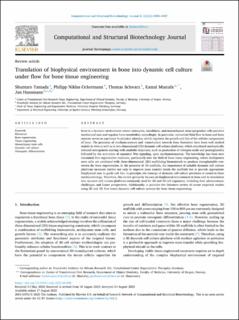| dc.contributor.author | Yamada, Shuntaro | |
| dc.contributor.author | Niklas Ockermann, Philipp | |
| dc.contributor.author | Schwarz, Thomas | |
| dc.contributor.author | Mustafa, Kamal Babikeir Elnour | |
| dc.contributor.author | Hansmann, Jan | |
| dc.date.accessioned | 2023-09-27T09:10:03Z | |
| dc.date.available | 2023-09-27T09:10:03Z | |
| dc.date.created | 2023-08-17T10:57:00Z | |
| dc.date.issued | 2023 | |
| dc.identifier.issn | 2001-0370 | |
| dc.identifier.uri | https://hdl.handle.net/11250/3092277 | |
| dc.description.abstract | Bone is a dynamic environment where osteocytes, osteoblasts, and mesenchymal stem/progenitor cells perceive mechanical cues and regulate bone metabolism accordingly. In particular, interstitial fluid flow in bone and bone marrow serves as a primary biophysical stimulus, which regulates the growth and fate of the cellular components of bone. The processes of mechano-sensory and -transduction towards bone formation have been well studied mainly in vivo as well as in two-dimensional (2D) dynamic cell culture platforms, which elucidated mechanically induced osteogenesis starting with anabolic responses, such as production of nitrogen oxide and prostaglandins followed by the activation of canonical Wnt signaling, upon mechanosensation. The knowledge has been now translated into regenerative medicine, particularly into the field of bone tissue engineering, where multipotent stem cells are combined with three-dimensional (3D) scaffolding biomaterials to produce transplantable constructs for bone regeneration. In the presence of 3D scaffolds, the importance of suitable dynamic cell culture platforms increases further not only to improve mass transfer inside the scaffolds but to provide appropriate biophysical cues to guide cell fate. In principle, the concept of dynamic cell culture platforms is rooted to bone mechanobiology. Therefore, this review primarily focuses on biophysical environment in bone and its translation into dynamic cell culture platforms commonly used for 2D and 3D cell expansion, including their advancement, challenges, and future perspectives. Additionally, it provides the literature review of recent empirical studies using 2D and 3D flow-based dynamic cell culture systems for bone tissue engineering. | en_US |
| dc.language.iso | eng | en_US |
| dc.publisher | Elsevier | en_US |
| dc.rights | Navngivelse 4.0 Internasjonal | * |
| dc.rights.uri | http://creativecommons.org/licenses/by/4.0/deed.no | * |
| dc.title | Translation of Biophysical Environment in Bone into Dynamic Cell Culture under Flow for Bone Tissue Engineering | en_US |
| dc.type | Journal article | en_US |
| dc.type | Peer reviewed | en_US |
| dc.description.version | publishedVersion | en_US |
| dc.rights.holder | Copyright 2023 The Author(s) | en_US |
| cristin.ispublished | true | |
| cristin.fulltext | original | |
| cristin.qualitycode | 1 | |
| dc.identifier.doi | 10.1016/j.csbj.2023.08.008 | |
| dc.identifier.cristin | 2167630 | |
| dc.source.journal | Computational and Structural Biotechnology Journal | en_US |
| dc.source.pagenumber | 4395-4407 | en_US |
| dc.identifier.citation | Computational and Structural Biotechnology Journal. 2023, 21, 4395-4407. | en_US |
| dc.source.volume | 21 | en_US |

